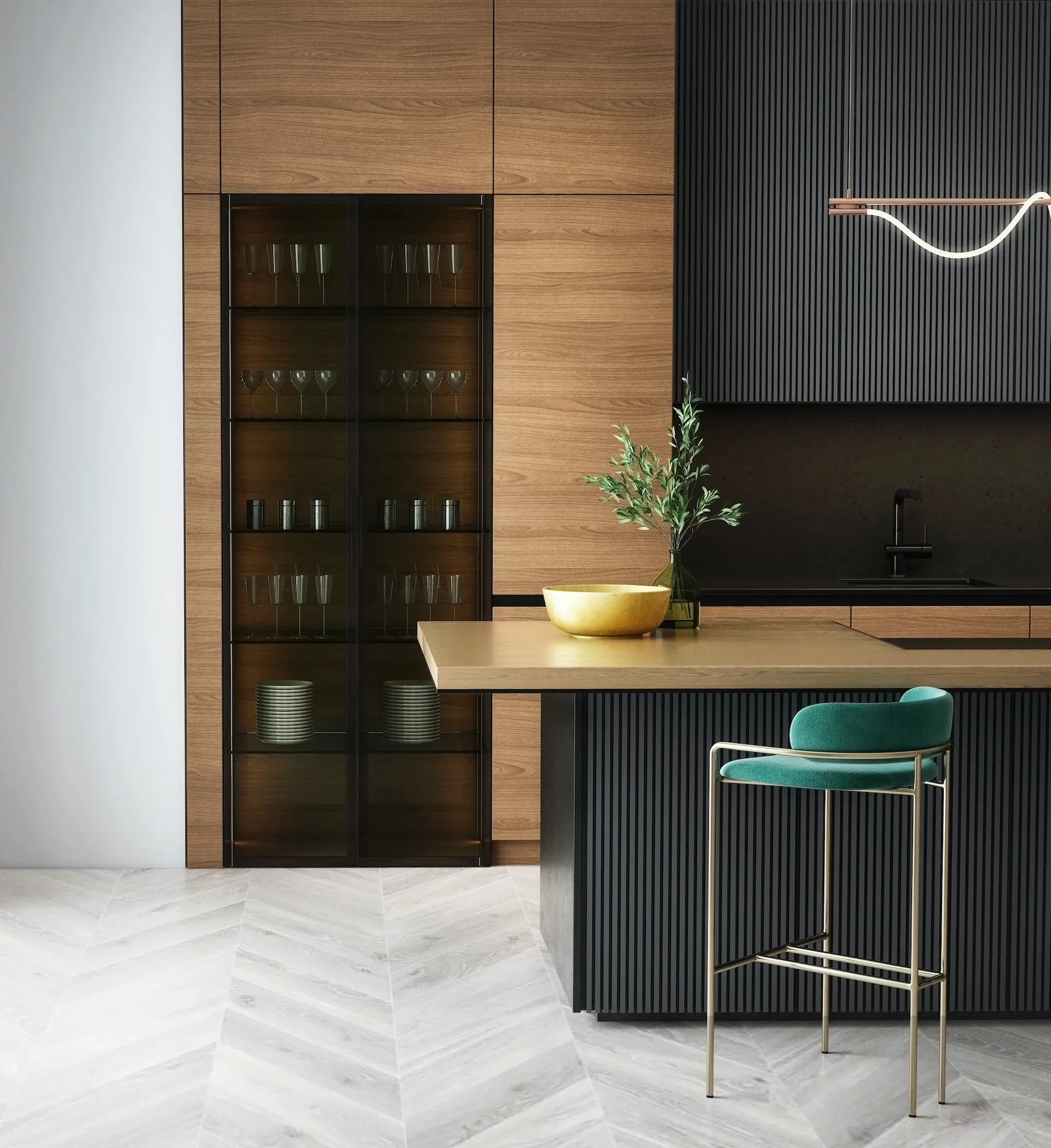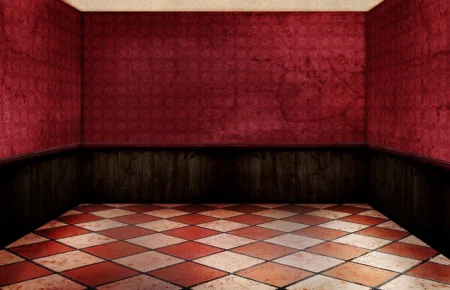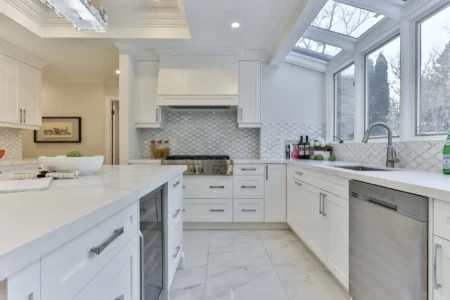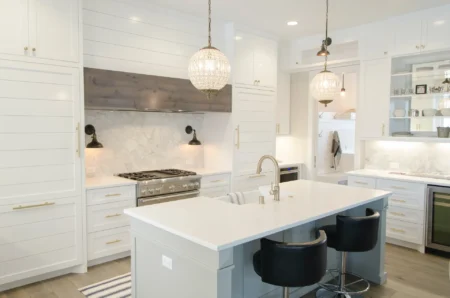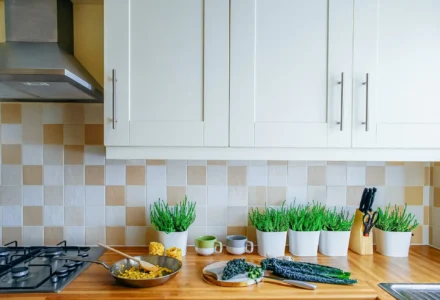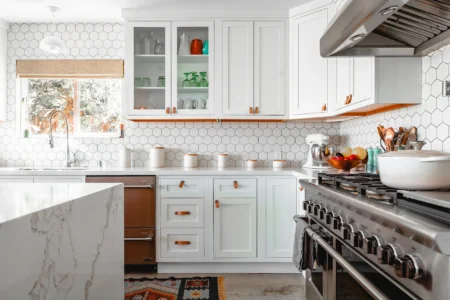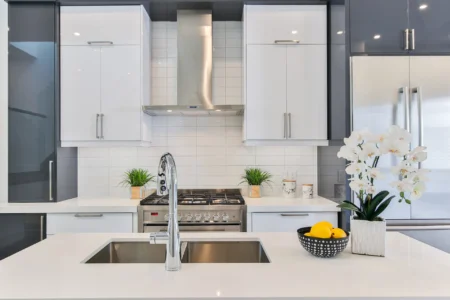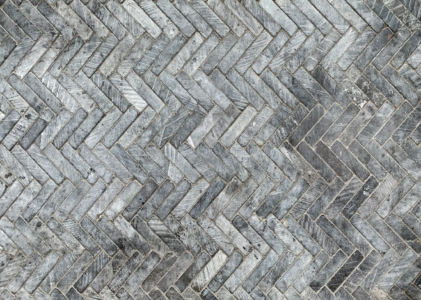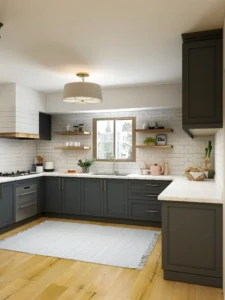The kitchen, often considered the heart of a home, requires careful planning and design, especially when it comes to its flooring. The right flooring can not only enhance the aesthetic appeal of your kitchen but also ensure its functionality and durability. In this blog, we will guide you through different types of kitchen flooring, how to match them with your kitchen style and budget, and the latest trends and innovations in the field. Let’s dive in!
Different Types of Kitchen Flooring
Choosing a kitchen floor might seem a simple task, but the variety of materials available can make it a daunting choice. Here, we break down the most popular types of kitchen flooring and their unique characteristics:
- Ceramic Tiles: Ceramic tiles are a classic choice for kitchen flooring due to their durability and resistance to water and stains. Available in a wide range of colors, patterns, and sizes, ceramic tiles can adapt to almost any kitchen style. However, they can be hard underfoot and prone to chipping if a heavy object is dropped on them.
- Hardwood: Hardwood floors bring warmth and natural beauty to a kitchen. They are highly durable and can last for decades with proper care. While hardwood floors can be on the pricier side, their timeless appeal and longevity often make them worth the investment. However, they require regular maintenance to prevent damage from moisture and scratches.
- Laminate: Laminate flooring is a more budget-friendly alternative that mimics the look of real wood or stone. It is easy to install and maintain, making it a popular choice for DIY enthusiasts. While laminate flooring is resistant to stains and can withstand heavy foot traffic, it is not as durable as hardwood or ceramic tiles and can be susceptible to water damage.
- Vinyl: Vinyl flooring is another cost-effective option that offers a wide variety of styles, including designs that mimic natural materials like wood or stone. It is comfortable underfoot, water-resistant, and easy to clean, making it a practical choice for busy kitchens. On the downside, vinyl flooring can be prone to dents and scratches over time.
- Stone: Natural stone floorings, such as granite, marble, or slate, add an elegant and luxurious touch to a kitchen. Each stone is unique, offering a range of colors and patterns. Natural Stone Tiles flooring is incredibly durable and can withstand heavy foot traffic. However, it can be expensive and requires sealing to prevent stains and water damage.
How to Match Your Flooring Material with Your Kitchen Style and Budget
Choosing the perfect flooring for your kitchen isn’t just about picking a material you like. It’s also about finding a balance between your kitchen’s style, your budget, and the flooring material’s practicality. Here’s how you can make a harmonious choice:
- Identify your kitchen style: First, you need to identify the style of your kitchen. Is it modern, traditional, rustic, or eclectic? This will help you narrow down your choices. For example, hardwood or stone flooring might be a better fit for a traditional or rustic kitchen, while ceramic tiles or vinyl could be more suitable for a modern or eclectic style.
- Assess your budget: Next, consider how much you’re willing to spend. Remember, the cost isn’t just about the material itself, but also about the installation and maintenance over the years. While hardwood and stone flooring are on the higher end, laminate and vinyl are more budget-friendly options. However, investing in a more expensive material might pay off in the long run in terms of durability and added home value.
- Consider the practicality: Finally, think about the practicality of the material. Are you a passionate cook who spends hours in the kitchen? Then you might prefer a comfortable and easy-to-clean floor like vinyl. Do you have young children or pets? Then you might want to opt for a more durable and scratch-resistant floor like ceramic tiles or hardwood.
- Seek professional advice: Don’t hesitate to seek advice from a professional interior designer or flooring expert. They can provide insights into the latest trends, and the best materials for your needs, and even help you find better deals.
- Try before you buy: Many companies offer samples that you can take home and test under different lighting conditions and against your kitchen cabinets and appliances. This can help you make a more informed decision.
The Latest Trends and Innovations in Kitchen Flooring Materials
As with any aspect of interior design, trends in kitchen flooring are constantly evolving. Technological advancements also bring about innovative materials and designs. Here are some of the latest trends and innovations you should know about:
- Sustainable Materials: With growing awareness about environmental issues, sustainable flooring options are becoming more popular. These include materials like bamboo and cork. Bamboo is a fast-growing plant, making it a renewable resource. It’s durable and gives a similar appearance to hardwood. Cork, on the other hand, is soft and comfortable underfoot, providing a unique aesthetic to the kitchen.
- Waterproof Flooring: Advances in technology have led to the development of truly waterproof flooring materials. This is especially beneficial for kitchens, which are prone to spills and moisture. Waterproof vinyl and laminate flooring options are becoming increasingly popular for their practicality and wide range of designs.
- Large Format Tiles: Large format tiles are a hot trend in contemporary kitchens. These tiles, larger than the standard 12×12 inches, offer a sleek, modern look and can make a small kitchen appear larger. They also have fewer grout lines, making them easier to clean.
- Textured Finishes: Textured finishes, such as hand-scraped or wire-brushed, are gaining popularity for the character and depth they add to the kitchen. These finishes can enhance the natural beauty of hardwood and stone flooring, making each piece unique.
- Bold Patterns and Colors: While neutral tones remain a classic choice, more homeowners are embracing bold patterns and colors to make a statement. From geometric patterns to colorful mosaics, these flooring options can add a touch of personality to your kitchen.
Conclusion
Choosing the right flooring material for your kitchen is a significant decision that requires careful consideration of various factors. Whether it’s understanding different types of kitchen flooring, matching them with your kitchen style and budget, or keeping up with the latest trends and innovations, every step is crucial in making an informed choice.
Remember, the perfect kitchen flooring is not just about aesthetics, but also about functionality, durability, and comfort. Don’t rush your decision. Take your time, do your research, and consider consulting with a professional if needed. With the right knowledge and advice, you can find a flooring material that transforms your kitchen into a space that’s both beautiful and practical.
Frequently Asked Questions (FAQs)
Why is choosing the right flooring material for my kitchen important?
Choosing the right flooring material is crucial as the kitchen floor is probably the most hardworking surface in the home, needing to withstand regular staining, water spills, and temperature fluctuations. The flooring also needs to be durable, hardwearing, and easy to clean, while still complementing the aesthetic of your space.
What are some durable materials to consider for my kitchen flooring?
Tile flooring, particularly ceramic or porcelain, is a time-tested option known for its durability and range of visual effects. However, some tiles, like limestone and travertine, are not recommended due to their propensity to scratch and absorb moisture, respectively.
Can I use wood for my kitchen flooring?
Yes, you can use wood for your kitchen flooring. Engineered wood flooring is particularly recommended because it is more resistant to warping and movement than solid wood. However, avoid using solid wood as it can warp when exposed to water.
Is laminate flooring a good choice for my kitchen?
Laminate flooring can be a cost-effective choice for your kitchen. Higher-end laminate can convincingly imitate the look of wood or tile. However, cheaper options might stain, warp, and peel. Always check if your chosen laminate can withstand the steamy conditions of your kitchen before purchasing.
Are there any alternative materials that I can use for my kitchen flooring?
Yes, alternative materials such as vinyl, rubber, and bamboo have been gaining popularity for kitchen flooring. These materials can be hard-wearing, water-resistant, and more cost-effective than traditional options.
